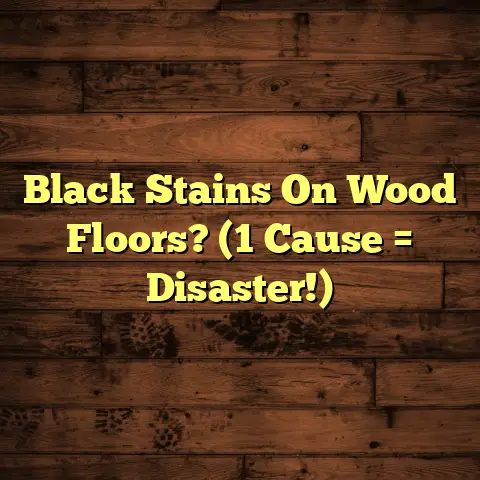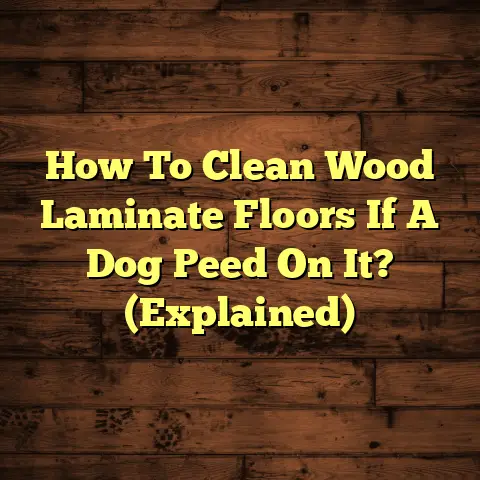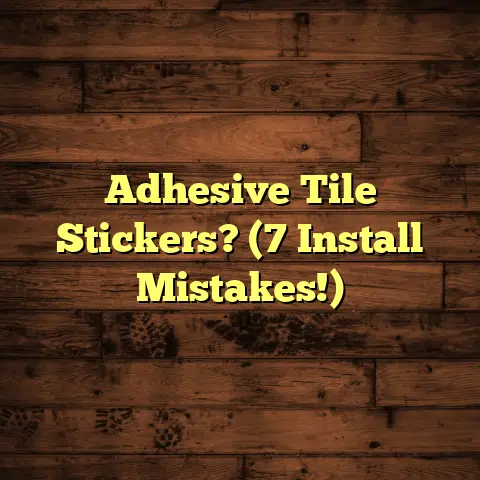Clean Mold On Cement Floor (8 Harsh Chemicals!)
Are you tired of spending hours trying to remove stubborn mold from your cement floors with little to no results?
I know the feeling. As a flooring contractor with over 15 years of experience, I’ve seen countless homeowners struggle with this exact problem.
Mold on cement floors, especially in basements, garages, and even outdoor patios, is a common issue. It’s not just unsightly; it poses real health risks. We’re talking respiratory issues, allergic reactions, and even more serious problems with prolonged exposure.
That’s why it’s crucial to address mold promptly and effectively. In this article, I’m going to walk you through eight harsh chemicals that can help you get the job done.
But before we dive in, remember: safety first! These are powerful substances, and you need to know how to use them correctly.
Section 1: Understanding Mold Growth on Cement Floors
1. What is Mold?
Mold is a type of fungus that thrives in damp environments. It plays a natural role in our ecosystem, breaking down organic matter. Think of it as nature’s recycler.
But when mold spores, which are everywhere, find their way into our homes and land on damp surfaces, they can quickly multiply and become a problem. These spores are microscopic and travel through the air, making their way in through open windows, doors, and even on our clothing.
2. Why Cement Floors Are Susceptible
Cement floors are particularly susceptible to mold growth because they can be porous and retain moisture. Think about it: basements are often damp, garages can get wet from cars, and outdoor patios are exposed to the elements.
These are perfect breeding grounds for mold. Humidity, moisture, and poor ventilation are the key culprits.
Here are some common areas in the home where I often see mold developing on cement floors:
- Basements (especially unfinished ones)
- Garages
- Laundry rooms
- Bathrooms (if they have cement flooring)
- Outdoor patios and walkways
I can’t tell you how many times I’ve walked into a basement and been hit with that musty mold smell. It’s a clear sign of a problem that needs to be addressed.
Section 2: The Dangers of Mold
1. Health Risks
Mold exposure can have a range of health consequences, depending on the type of mold, the length of exposure, and the individual’s sensitivity. Some people are more susceptible than others, especially those with allergies, asthma, or weakened immune systems.
Here are some potential health effects of mold exposure:
- Respiratory problems: Coughing, wheezing, shortness of breath, and nasal congestion.
- Allergic reactions: Skin rashes, itching, watery eyes, and sneezing.
- Asthma attacks: Mold can trigger asthma attacks in people with asthma.
- Headaches: Frequent headaches can be a sign of mold exposure.
- Fatigue: Feeling tired and lethargic.
- Irritation of the eyes, nose, and throat: Burning sensations and discomfort.
In more severe cases, mold exposure can lead to more serious health problems, such as fungal infections and lung damage.
According to the CDC, “In 2004, the Institute of Medicine (IOM) found there was sufficient evidence to link indoor exposure to mold with upper respiratory tract symptoms, cough, and wheeze in otherwise healthy people; with asthma symptoms in people with asthma; and with hypersensitivity pneumonitis in individuals susceptible to that condition.” (https://www.cdc.gov/mold/faqs.htm)
2. Structural Damage
Mold isn’t just a health hazard; it can also compromise the structural integrity of your cement flooring and surrounding structures.
Mold feeds on organic materials, and while cement itself isn’t organic, mold can grow on dirt, dust, and other organic matter that accumulates on the surface. Over time, this can weaken the cement and cause it to crumble or crack.
Additionally, mold can spread to nearby wood framing, drywall, and other building materials, causing even more extensive damage. I’ve seen cases where mold infestations have required costly repairs and renovations.
Section 3: Preparing for Mold Removal
1. Safety Precautions
Before you even think about reaching for those harsh chemicals, you need to take some serious safety precautions. I cannot stress this enough. Your health and safety are paramount.
Here’s what you need:
-
Protective gear:
- Respirator: A NIOSH-approved respirator is essential to protect your lungs from mold spores and chemical fumes. Don’t skimp on this.
- Gloves: Wear heavy-duty, chemical-resistant gloves to protect your skin.
- Eye protection: Goggles or a face shield will prevent splashes from getting in your eyes.
- Protective clothing: Wear long sleeves, long pants, and shoes that you can easily wash or dispose of.
-
Proper ventilation: Open windows and doors to create airflow. Use fans to circulate the air and exhaust fumes outside. If possible, use a HEPA air purifier to remove mold spores from the air.
-
Keep pets and children away: Ensure that pets and children are kept out of the area during and after the mold removal process. Chemicals can be harmful if ingested or inhaled.
2. Initial Assessment
Before you start scrubbing, take a moment to assess the extent of the mold problem.
-
Identify the type of mold: While it can be difficult to identify the exact species of mold without professional testing, you can get a general idea based on its appearance. Is it black, green, white, or another color? Is it fuzzy or slimy?
-
Determine the size of the affected area: Is it a small patch or a large infestation? This will help you determine how much chemical you need and how long the process will take.
-
Identify the source of the moisture: Where is the moisture coming from? Is it a leaky pipe, a crack in the foundation, or just high humidity? Addressing the source of the moisture is crucial to prevent mold from returning.
Once you’ve assessed the situation, you can determine the best approach for removal. For small patches of mold, you may be able to handle it yourself with the chemicals I’m about to discuss. But for large infestations, I recommend calling in a professional mold remediation company.
Section 4: 8 Harsh Chemicals for Mold Removal
Okay, let’s get down to business. Here are eight harsh chemicals that can effectively kill mold on cement floors. Remember to always follow the manufacturer’s instructions and safety precautions when using these chemicals.
1. Bleach
Bleach, or sodium hypochlorite (NaClO), is a common household cleaner and disinfectant that’s effective at killing mold on non-porous surfaces like cement.
How it works: Bleach oxidizes the mold, essentially breaking down its cellular structure. It’s a powerful disinfectant that kills most types of mold on contact.
Effectiveness: Bleach is highly effective at killing surface mold. However, it doesn’t penetrate deeply into porous materials, so it may not kill mold that has taken root beneath the surface.
Limitations: Bleach can discolor or damage certain materials, and it’s not effective at removing mold stains. It also releases harmful fumes, so proper ventilation is essential.
My experience: I’ve used bleach many times to clean mold on cement floors, especially in bathrooms and laundry rooms. It’s a quick and easy solution for surface mold, but it’s not a long-term fix if the underlying moisture problem isn’t addressed.
2. Hydrogen Peroxide
Hydrogen peroxide (H2O2) is a mild antiseptic and bleaching agent that’s effective at killing mold and removing stains.
How it works: Hydrogen peroxide oxidizes mold spores, breaking them down and preventing them from reproducing. It’s also a good stain remover.
Effectiveness: Hydrogen peroxide can penetrate surfaces more effectively than bleach, making it a good choice for porous materials like cement. It’s also less toxic and doesn’t produce harmful fumes.
Limitations: Hydrogen peroxide is not as strong as bleach, so it may require multiple applications to kill all the mold. It can also lighten or discolor certain materials.
My experience: I often recommend hydrogen peroxide for homeowners who are sensitive to bleach fumes. It’s a safer alternative that’s still effective at killing mold and removing stains.
3. Ammonia
Ammonia (NH3) is a strong chemical that can kill mold on hard, non-porous surfaces.
How it works: Ammonia is a strong alkaline substance that disrupts the mold’s cellular structure.
Effectiveness: Ammonia is effective at killing surface mold on non-porous surfaces like cement.
Limitations: Never mix ammonia with bleach! The combination produces toxic fumes that can be fatal. Ammonia is also not effective on porous materials and can damage certain surfaces.
My experience: I rarely use ammonia for mold removal because of the safety concerns. There are safer and more effective alternatives available.
4. Sodium Hydroxide (Lye)
Sodium hydroxide (NaOH), also known as lye, is a highly caustic chemical that can dissolve organic matter, including mold.
How it works: Sodium hydroxide is a strong alkali that breaks down the chemical bonds in mold cells, effectively destroying them.
Effectiveness: Sodium hydroxide is very effective at killing mold, but it’s also very dangerous.
Limitations: Sodium hydroxide is highly corrosive and can cause severe burns to the skin and eyes. It should only be used by experienced professionals with proper safety equipment.
My experience: I only use sodium hydroxide in very specific situations, such as cleaning heavily soiled or contaminated surfaces. It’s a last resort chemical that requires extreme caution.
5. Boric Acid
Boric acid (H3BO3) is a mild acid with antifungal and insecticidal properties.
How it works: Boric acid disrupts the metabolism of mold cells, preventing them from growing and reproducing.
Effectiveness: Boric acid is effective at preventing mold growth, but it’s not as effective at killing existing mold.
Limitations: Boric acid is not as strong as other chemicals on this list, and it may require multiple applications. It’s also toxic if ingested.
My experience: I often use boric acid as a preventative measure after cleaning mold. It helps to inhibit future mold growth.
6. Trisodium Phosphate (TSP)
Trisodium phosphate (Na3PO4), or TSP, is a powerful cleaning agent that can remove mold, grease, and dirt.
How it works: TSP is a strong alkaline substance that breaks down dirt, grease, and mold.
Effectiveness: TSP is effective at cleaning mold and preparing surfaces for painting or sealing.
Limitations: TSP can be harsh on certain surfaces and can damage paint or finishes. It’s also harmful to the environment.
My experience: I use TSP primarily for cleaning and preparing surfaces before applying sealers or coatings. It’s a good all-purpose cleaner that can also help to remove mold.
7. Vinegar
Vinegar, specifically white distilled vinegar, is a natural acid that can kill mold and bacteria.
How it works: Vinegar’s acidity disrupts the growth of mold and breaks down its cellular structure.
Effectiveness: Vinegar is effective at killing many common types of mold, including black mold. It’s also a safe and natural alternative to harsh chemicals.
Limitations: Vinegar is not as strong as bleach or other chemicals, so it may require multiple applications. It also has a strong odor that some people find unpleasant.
My experience: I often recommend vinegar as a first-line treatment for small patches of mold. It’s a safe and effective option that most homeowners already have on hand.
8. Commercial Mold Removers
There are many commercial mold removers available on the market, ranging from mild to very harsh.
How they work: Commercial mold removers typically contain a blend of chemicals that kill mold, remove stains, and prevent future growth.
Effectiveness: The effectiveness of commercial mold removers varies depending on the product and the type of mold.
Limitations: Some commercial mold removers can be very harsh and contain harmful chemicals. Always read the label carefully and follow the manufacturer’s instructions.
My experience: I’ve used many different commercial mold removers over the years. Some are very effective, while others are a waste of money. It’s important to do your research and choose a product that’s appropriate for your specific situation.
Section 5: Step-by-Step Guide to Cleaning Mold from Cement Floors
Now that you know about the different chemicals you can use, let’s walk through the process of cleaning mold from cement floors.
1. Gathering Supplies
Before you start, make sure you have all the necessary supplies:
- The chosen chemical (bleach, hydrogen peroxide, etc.)
- Protective gear (respirator, gloves, eye protection, protective clothing)
- Spray bottle or bucket
- Scrub brush
- Shop vacuum with HEPA filter
- Clean cloths or paper towels
- Fan for ventilation
2. Application of Chemicals
Here’s a general step-by-step guide for applying the chemicals:
-
Prepare the area: Remove any furniture or other items from the area. Cover any nearby surfaces that you don’t want to get wet or damaged.
-
Mix the chemical: Follow the manufacturer’s instructions for mixing the chemical. For example, if you’re using bleach, mix one part bleach with ten parts water.
-
Apply the chemical: Apply the chemical to the affected area using a spray bottle or bucket. Make sure to saturate the moldy surface.
-
Scrub the surface: Use a scrub brush to agitate the mold and loosen it from the surface.
-
Let it sit: Allow the chemical to sit on the surface for 10-15 minutes to kill the mold spores.
-
Rinse the surface: Rinse the surface with clean water to remove any chemical residue.
-
Dry the surface: Use clean cloths or paper towels to dry the surface. You can also use a fan to speed up the drying process.
Important tips:
- Always work in a well-ventilated area.
- Wear protective gear at all times.
- Follow the manufacturer’s instructions for each chemical.
- Don’t mix chemicals unless specifically instructed to do so.
- Test the chemical on a small, inconspicuous area first to ensure it doesn’t damage the surface.
- Repeat the process if necessary to remove all the mold.
3. Post-Cleaning Procedures
After you’ve cleaned the mold, it’s important to take steps to prevent it from returning:
-
Ventilate the area: Open windows and doors to allow fresh air to circulate. Use fans to dry the area completely.
-
Clean up: Dispose of any contaminated materials, such as cloths or paper towels, in a sealed plastic bag.
-
Monitor the area: Keep an eye on the area for any signs of returning mold.
Section 6: Preventing Future Mold Growth
The best way to deal with mold is to prevent it from growing in the first place. Here are some tips for preventing future mold growth on cement floors:
1. Controlling Humidity
Mold thrives in humid environments, so it’s important to keep humidity levels in check.
-
Use a dehumidifier: A dehumidifier can help to remove excess moisture from the air, especially in basements and other damp areas.
-
Improve ventilation: Make sure your home is well-ventilated by opening windows and doors regularly.
-
Fix leaks: Repair any leaks in your roof, plumbing, or foundation to prevent water from entering your home.
2. Regular Maintenance
Regular cleaning and inspections can help to catch mold early before it becomes a major problem.
-
Clean regularly: Clean your cement floors regularly with a mild detergent and water.
-
Inspect for leaks: Check for leaks around plumbing fixtures, windows, and doors.
-
Look for signs of mold: Be on the lookout for any signs of mold growth, such as musty odors, discoloration, or visible mold.
3. Sealing and Waterproofing
Sealing and waterproofing your cement floors can help to prevent moisture from penetrating the surface.
-
Apply a sealer: Apply a concrete sealer to your cement floors to create a barrier against moisture.
-
Waterproof the foundation: Waterproof your foundation to prevent water from seeping into your basement.
Conclusion
Mold on cement floors is a common problem, but it’s one that you can tackle head-on with the right tools and knowledge. Remember to prioritize safety when working with harsh chemicals, and always take steps to prevent mold from returning.
Don’t let mold take over your home. Take action as soon as you notice it, and choose the right chemical for your specific situation. With a little effort, you can keep your cement floors clean, healthy, and mold-free!





